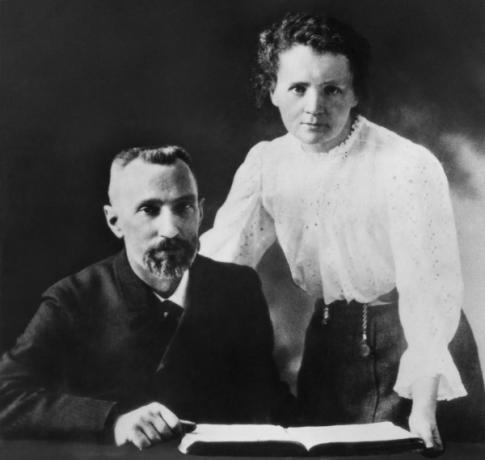O curium, symbol Cm and atomic number 96, is one of the actinides of Periodic table. It is an element that cannot be found in nature and therefore can only be obtained in the laboratory. In its metallic form, it has a silver color, is shiny and malleable. In solution, it is commonly in the +3 oxidation state. It has 20 isotopes, the main ones being mass 242, 244 and 248.
This element can be obtained by exposing heavy nuclei, such as plutonium and americium isotopes, to neutrons. It is estimated that 20 grams of curium can be obtained from 1 ton of nuclear waste.
In terms of application, curium stands out for its great radioactive activity and as a particle emitter alpha. It was first synthesized at the end of World War II and named after the French couple Pierre and Marie Curie.
Read too:Actin — actinide that can be used to treat cancer
Topics in this article
- 1 - Summary about curium
- 2 - Properties of curium
- 3 - Characteristics of Curium
- 4 - Obtaining curium
- 5 - Applications of curium
- 6 - History of curium
Summary about Curium
Curium is a metal belonging to block f of the Periodic Table.
In metallic form, it has a silver color, besides being shiny and malleable.
In solution, your main NOx is +3, because of the stability of the 5f sublevel7.
It has 20 known isotopes, whose masses range from 232 to 252.
It cannot be found in nature and can only be synthesized in the laboratory.
It has great radioactive activity and stands out for being an alpha particle emitter.
It was first synthesized at the end of World War II by Seaborg, James and Ghiorso.
Curium properties
Symbol: Cm.
atomic number: 96.
atomic mass: 247 c.u.
electronegativity: 1,3.
Fusion point: 1345°C.
Boiling point: 3110°C (calculated).
Density: 13.51 g.cm-3 (calculated).
electronic configuration: [Rn] 7s2 5f7 6d1.
chemical series: actinides, f-block, internal transition elements.
Do not stop now... There's more after the ad ;)
Curium characteristics
With symbol Cm and atomic number 96, curium is a metal belonging to the actinide group (f block) of the Periodic Table. É shiny in its metallic form, in addition to being malleable and silvery in color, with properties that are similar to the lighter actinides.
Metallic curium appears to be much more susceptible to corrosion than the previous actinides. Quickly dissolves in dilute acidic solutions and in contact with air, it quickly forms a protective oxide layer, which starts as CmO, passing through Cm2O3, until reaching CmO2 at high temperatures. It can react with most of the nonmetals of the Periodic Table.
Twenty isotopes of Cm are known, whose masses range from 232 to 252, but none of them are found in nature, all are produced in the laboratory. Of these, only three are available in sufficient quantity for studies — 242cm, 244cm and 248cm. While the two lighter isotopes account for 90% of production, the mass 248 isotope is desired for studies, as its half life is about 3.5 x 105 years old.
It preferentially adopts the +3 oxidation state, since the 5f sublevel7 (half-filled) ensures greater stability.
Read too: Thorium — actinide that has been studied as a fuel for nuclear power plants
obtaining the curium
the curium not an element found in nature, requiring its production in the laboratory. Thus, it is characterized as a synthetic element.
intense exposure of neutrons to isotopes 242Pu and 243Am in nuclear reactors is able to form significant amounts of the isotopes 244cm, 246cm and 248Cm, with smaller amounts of the odd-mass isotopes 245cm and 247cm. It is estimated that 20 grams of curium can be produced from 1 ton of nuclear waste.
The metallic form of curium is prepared by the reduction of curium III fluoride (CmF3) using metallic barium or lithium.
Curium applications
O 242cm and the 244Cm show high radioactive activity (1012 at 1015 Bq.g-1), therefore, they were studied as heat sources for energy generation in aerospace programs. However, the high costs and operational difficulties made the application prohibitive.
Even so, the 244Cm was even sent into space to be an alpha particle emitter in X-ray spectrometry devices for analyzing Martian rocks.
O 242Cm was used to produce an isotope 238More stable Pu, applied in generation of thermoelectric energy in devices, including some models of cardiac pacemakers. already the 245cm and the 248Cm were used as targets for the synthesis of the newly discovered element livermorium (Lv, atomic number 116).
history of curium
Curium is not as famous as plutonium and uranium, the best known elements of the actinide series. Not being found in nature, it was prepared (more specifically the 242Cm) first in 1944 by Seaborg, James and Ghiorso, bombing a nucleus of 239Pu with alpha particles. Soon after, element 95, americium, was also discovered.
The team, due to Second World War, kept the two findings hidden. However, on Armistice Day, November 11, 1945, Seaborg himself spoke on an American television program, the kids quiz, about the discovery of the two new elements.

Element 96 is named in honor of the couple Pierre and Marie Curie, who revolutionized science with his discoveries about the radioactivity.
By Stefano Araújo Novais
Chemistry teacher
